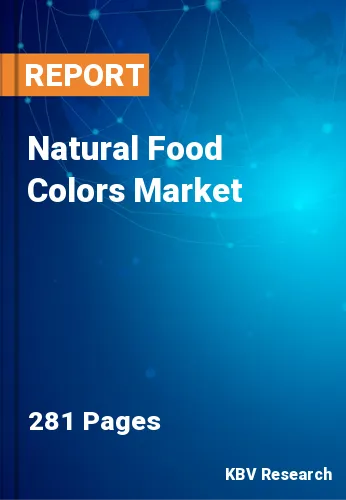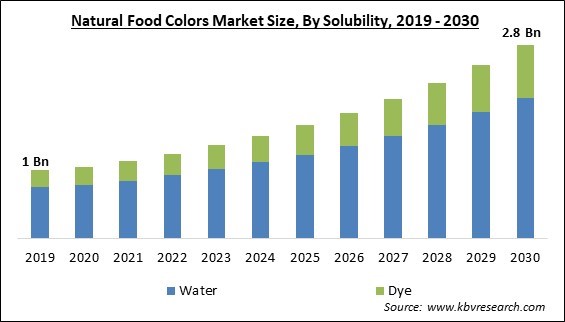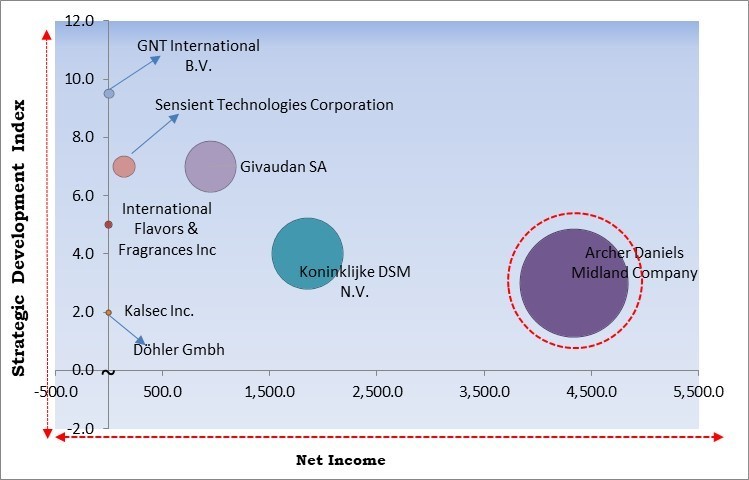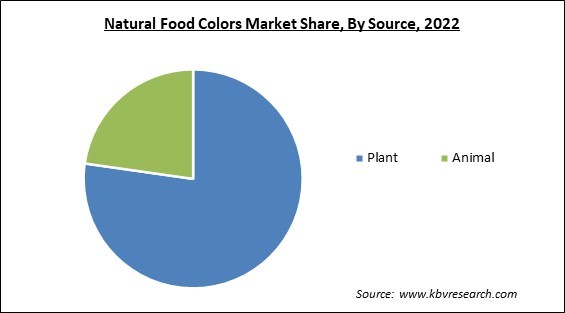
The Global Natural Food Colors Market size is expected to reach $2.8 billion by 2030, rising at a market growth of 11.0% CAGR during the forecast period.
Carotenoids are highly utilized in natural food colors as they boost the product's attractiveness, deliciousness, and appeal while enabling consumers to recognize products at a peak. Therefore, Carotenoids accounted for more than 2/5th share of the market in 2022. They are pigments produced by plants in the colors yellow, orange, and red. The four most prevalent carotenoids are zeaxanthin, lutein, lycopene, and beta-carotene. Brightly colored fruits and vegetables such as spinach, kale, corn, orange bell peppers, tomatoes, watermelon, pink grapefruit, cantaloupe, broccoli, and carrots are food sources of these chemicals. Dietary carotenoids have been shown through observational studies to provide health advantages by lowering the risk of disease, particularly certain types of tumors and eye conditions. Due to this health advantage, the usage of carotenoids as natural food color is rising gradually.

The major strategies followed by the market participants are Product Launches as the key developmental strategy to keep pace with the changing demands of end users. For instance, In May, 2023, EXBERRY, a brand of GNT released an orange shade composed of paprika pulp and paprika oil. The new shade is used for applications in oil coatings for sauces and snacks. Additionally, In September, 2022, Givaudan SA released Purple 23641. The Purple 23641 is a vegan color used for make-up applications. The new color is composed of green extractions from Raphanus Sativus L.
Based on the Analysis presented in the KBV Cardinal matrix; Archer Daniels Midland Company is the forerunner in the Market. In April, 2019, Archer Daniels Midland’s (ADM) Wild Flavors and Specialty Ingredients Business Unit announced the launch of micronized color powders. The micronized color powders are made of paprika extract and coloring food material to give an orange shade. The new powders can be used for many varieties of applications. Companies such as Koninklijke DSM N.V., Givaudan SA, and Sensient Technologies Corporation are some of the key innovators in the Market.

Due to growing consumer knowledge of organic products, the health risks of synthetic colors, and the advantages of natural food colors in terms of health, natural food colors are becoming increasingly popular over synthetic food colors. The rapid use of artificial production methods to boost the food supply has created a number of health risks. The global demand for naturally grown food items is driven by growing health consciousness and a preference for environmentally friendly products. As a result, natural food colors are frequently used by food manufacturers to enhance the visual appeal of processed foods and beverages.
The use of numerous technologies in the food and beverage industry is expanding and experiencing significant developments. In order to determine the true potential and availability of natural dye-yielding resources, extensive scientific research is being conducted. The market is greatly being impacted by the changing dietary preferences of consumers. The need for functional foods, the use of cutting-edge processes like microencapsulation and nanoencapsulation, and changing lifestyles are all driving the market. An increase in the number of health-conscious consumers, an improvement in the standard of living, an increase in the lifespan as well as product appeal, and a rise in the rate of obesity and diabetes are rising their popularity.
Natural food colors are typically more unstable when compared with synthetic colors during processing, handling, and storage. Changes in atmospheric or processing variables, such as pH, temperature, and light, affect the stability of colors. While certain natural colors lose appeal with time, others might begin to decolorize the final product during processing. Because they add brilliant colors to the finished food and beverage goods at a reasonable price, synthetic colors are preferred more by manufacturers of food and beverage products. As a result, the demand is declining and thus the market is predicted to witness slow growth during the course of projection period.
On the basis of solubility, the market is segmented into water, and dye. In 2022, the water segment dominated the market with the maximum revenue share. The food and beverage industries greatly demand water-soluble food colors because of their highly concentrated color, good quality-price ratio, and high-water stability. The need for natural food colors is anticipated to rise significantly as the consumption of juices, carbonated soft drinks, and other such beverages gradually rises.

Based on application, the market is classified into processed food products, and beverages. The beverages acquired a substantial revenue share in the market in 2022. The growing customer preference for beverages, which is increasingly impacted by the drink's color, fuels the demand in the beverage sector. Products are chosen by consumers more frequently based on look than flavor due to which beverage manufacturing companies are switching to natural food colors that give beverages a more authentic appearance.
By color type, the market is categorized into carmine, annatto, caramel, chlorophyll & spirulina, carotenoids, anthocyanins, and curcumin. In 2022, the anthocyanins covered a considerable revenue share in the market in 2022. Fruits and vegetables contain anthocyanins, which are the pigments that give them their red, purple, and blue colors. Foods high in anthocyanins include berries, currants, grapes, and a number of tropical fruits. Edible vegetables with a high anthocyanin content include leafy vegetables that range in color from red to purplish to blue, as well as grains, roots, and starches.
On the basis of source, the market is segmented into plants and animals. The plant segment generated the maximum revenue share in the market in 2022. Natural food colors generated from plants are considered clean-label ingredients because they come from organic sources. Due to rising consumer demand for natural and organic food items, producers of food components have focused on plant-based food colors. The market for plant-based food colors is anticipated to be driven by factors such as rising veganism, rising clean-label product consumption, rising health consciousness, and rising interest in environmentally friendly products.
Based on form, the market is classified into liquid, and powder. In 2022, the liquid segment recorded a remarkable revenue share in the market. This is due to its increasing use in the production of food and beverage goods to improve viscosity, product stability, texture, shelf life, pleasant taste, and visual aspect. Furthermore, this segment is predicted to increase at a large rate, owing to its increasing use and strong microbiological stability.
| Report Attribute | Details |
|---|---|
| Market size value in 2022 | USD 1.2 Billion |
| Market size forecast in 2030 | USD 2.8 Billion |
| Base Year | 2022 |
| Historical Period | 2019 to 2021 |
| Forecast Period | 2023 to 2030 |
| Revenue Growth Rate | CAGR of 11% from 2023 to 2030 |
| Number of Pages | 281 |
| Number of Table | 535 |
| Report coverage | Market Trends, Revenue Estimation and Forecast, Segmentation Analysis, Regional and Country Breakdown, Competitive Landscape, Companies Strategic Developments, Company Profiling |
| Segments covered | Solubility, Application, Source, Form, Color Type, Region |
| Country scope | US, Canada, Mexico, Germany, UK, France, Russia, Spain, Italy, China, Japan, India, South Korea, Singapore, Malaysia, Brazil, Argentina, UAE, Saudi Arabia, South Africa, Nigeria |
| Growth Drivers |
|
| Restraints |
|
Region wise, the market is analyzed across North America, Europe, Asia Pacific, and LAMEA. In 2022, the Europe region led the market by generating the highest revenue share. Over the forecast period, the market will expand due to rising consumer awareness about diseases risk associated with synthetic colors, such as cancer and other cardiovascular diseases, and the establishment of laws and regulations restricting synthetic dyes. In addition, the demand will increase with the rising demand for bakery items.
Free Valuable Insights: Global Natural Food Colors Market size to reach USD 2.8 Billion by 2030
The market research report covers the analysis of key stake holders of the market. Key companies profiled in the report include Archer Daniels Midland Company, Koninklijke DSM N.V., Döhler Gmbh, International Flavors & Fragrances Inc, GNT International B.V., Kalsec Inc., Givaudan SA, Sensient Technologies Corporation, Kanegrade Ltd. and Taiyo International (Taiyo Kagaku Corporation).
By Solubility
By Application
By Source
By Form
By Color Type
By Geography
The Market size is projected to reach USD 2.8 billion by 2030.
Technology development and expansion in the food and beverage sector are driving the Market in coming years, however, The demand for synthetic food colors is driven by the low stability of natural colors restraints the growth of the Market.
Archer Daniels Midland Company, Koninklijke DSM N.V., Döhler Gmbh, International Flavors & Fragrances Inc, GNT International B.V., Kalsec Inc., Givaudan SA, Sensient Technologies Corporation, Kanegrade Ltd. and Taiyo International (Taiyo Kagaku Corporation).
The Powder segment is generating the highest revenue share in the Global Natural Food Colors Market by Form in 2022 thereby, achieving a market value of $1.8 billion by 2030.
The Processed Food Products segment is leading the Global Natural Food Colors Market by Application in 2022 thereby, achieving a market value of $1.7 billion by 2030.
The Europe market dominated the Global Natural Food Colors Market by Region in 2022, and would continue to be a dominant market till 2030; thereby, achieving a market value of $977.6 million by 2030.
Our team of dedicated experts can provide you with attractive expansion opportunities for your business.
